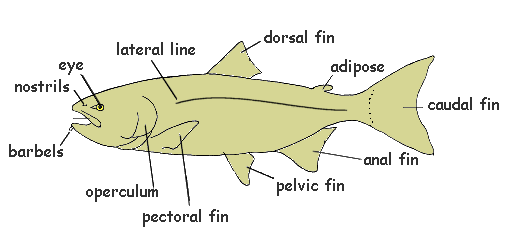|
|
Fish Anatomy It is important for the children to be able to identify the different parts of a fish. Use a diagram such as the one below to identify the major parts of a fish. You can find fish pillows at some department stores which show the parts of a fish and are good illustrations.
The
gill cover, called an operculum, protects the gills.
Agnathas (jawless fish), sharks and rays have gill slits. Water passes
through the mouth and over the gills of the fish.
As the water passes over the gills, oxygen enters the fish’s
bloodstream and is carried throughout its body. The nostrils of a bony fish are
used for smelling and not for breathing.
Bony
fish have fins that are used for swimming, stability, and steering.
The dorsal and anal fins keep the fish level in the water and keep it
from rolling. The
caudal fin helps propel the fish forward and steer.
The pelvic fins help keep the fish level in the water.
The pectoral fins help the fish steer and brake. The lateral line is a sense organ that helps the fish detect vibrations in the water. Bony fish anatomy worksheets - Word file Shape: Fish have six main body shapes: flat (rays, skates, flounder, sole), fusiform (sharks, salmon, barracuda, tuna), eel like or elongated (eels, lamprey, needlefish), compressed (butterfly fish, angel fish), round (porcupine fish) and ribbon (cutlass).
Fish body shape activity - word file Graphics by |
||||||||||||






